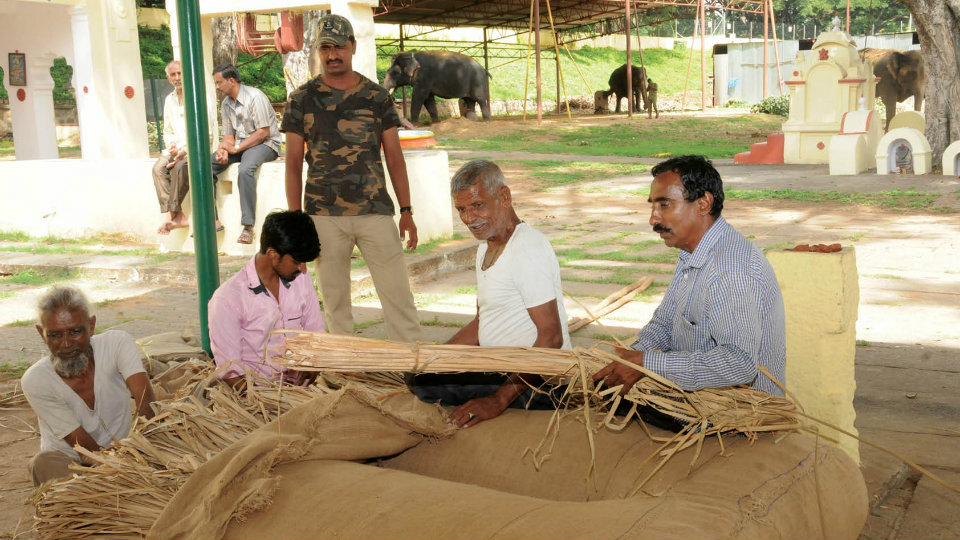As the countdown to the historic Jumboo Savaari (Vijayadashami procession) begins, the Gaadhi (cushion) and Namdha (thick decorative rug) preparations have also begun. The Gaadhi acts as cushion to Arjuna, the lead elephant, who will carry the coveted 750-kilogram Golden Howdah on his back during the Jumboo Savaari procession this Dasara. The Gaadhi will make life smoother for the Howdah-Elephant, as he marches with his troupe from Mysore Palace to Bannimantap Grounds on the Dasara procession day on Oct.19.
Retired mahouts and skilled Gaadhi and Namdha makers, Zakaulla and Pasha are currently preparing the Gaadhi at Someshwara Temple premises in the Palace. They are using their skills to prepare the cushion of the Howdah Elephant, Arjuna who himself weighs more than 6,350 kgs.
The Gaadhi and Namdha preparation is an old tradition that has been carried out since the erstwhile Maharaja days. The Gaadhis and Namdhas act as relief-agents for Arjuna, the Howdah Elephant, making his march easy and comfortable. Because of the cushion and the woollen rug, the Howdah Elephant is able to march through the 5-km stretch without any discomfort or injury.
Even during the rehearsals and route-familiarisation exercises with the sand bags and wooden howdah, the Gaadhis and Namdhas are used on the Howdah elephant to avoid any mishaps or injuries. This Dasara, great care is being taken to ensure that all precautionary measures are carried out diligently towards the safety and well-being of the Howdah Elephant.
Mahouts, Zakaulla and Pasha have been preparing the Gaadhi and Namdha for the last 13 years during the Dasara festival. Preparing the Gaadhis and Namdhas is a rare skill that Zakaulla and Pasha Gaadhi have acquired from their ancestors. This tradition has been kept alive with one generation passing this skill to the next one. Zakaulla and Pasha have retired from mahout duties, after serving and caring for the elephants, Chaitra and Sarala for many years. Pasha now works as a special mahout for the Dasara elephants in the forest department.
These ex-mahouts prepare the Gaadhis and Namdhas using Papyrus grass (Cyperus Papyrus), a grass that usually thrives in lakes, tanks, and other water bodies. The mahouts would collect the grass from the water bodies, dry it out under the sun for a period of 20-30 days, and then use the grass for the Gaadhi and Namdha preparations accordingly.
The Gaadhis are usually six-foot in length and five-foot in width. The mahouts ensure that the Gaadhis can be adjusted with the Howdah and there are no chances of mishap when the elephant carries the Howdah on its back. Gunny bags are filled with the water-resistant grass in a circular fashion and then prepared like a pillow to make the final product, the Gaadhis. The Namdhas are also readied like pillows by using coconut coir.
After mounting the Gaadhi and Namdha on the back of the Howdah Elephant, the mahouts would then decorate the cushion strap with ornamental clothes.
The Gaadhi and Namdha will act as a cushion for the Howdah-Elephant as there are chances of injuries, while mounting and tying the Golden Howdah on the elephant’s back during the Jumboo Savaari procession and other related rehearsal events. This is a tradition which we have continued to this day.
—Dr. D.N. Nagaraj, Veterinarian
By M.T. Yogesh Kumar








Recent Comments